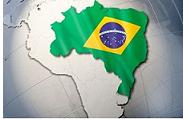Annual Rate
Brazil's first-quarter GDP expanded 9% from year ago
 Brazil's economy grew at its fastest annual rate since 1995 in the first quarter, sending the real and bond yields higher and cementing expectations that the central bank will raise interest rates by at least 0.75 percentage point tomorrow to prevent overheating.
Brazil's economy grew at its fastest annual rate since 1995 in the first quarter, sending the real and bond yields higher and cementing expectations that the central bank will raise interest rates by at least 0.75 percentage point tomorrow to prevent overheating.
Gross domestic product expanded 9 percent from a year earlier, faster than any other Latin American economy. The figure was higher than the median forecast of 8.5 percent among 41 analysts surveyed by Bloomberg. GDP grew 2.7 percent from the previous quarter.
"If this isn't a V-shaped recovery, I don't know what is," said Neil Shearing, a senior emerging-markets economist at Capital Economics Ltd., in a phone interview from London. "What makes Brazil unique is the strength of domestic demand. Retail sales have been staggeringly strong over the past three or four months."
First-quarter expansion was not so fast -- eight of 41 economists surveyed by Bloomberg expected higher growth -- that it will alter the pace of central bank interest rate increases, said Jankiel Santos, chief economist at Banco Espirito Santo de Investimento,
"The last increase was enough to anchor inflation expectations," Santos said in a telephone interview from Sao Paulo. "I don't think the central bank is going to raise rates higher than before given this figure."
The yield on interest rate futures contracts due in January 2012, the most traded on the Sao Paulo BM&F futures exchange, rose three basis points to 11.86 percent at 9:58 a.m. New York time. The real, which has strengthened 4.7 percent against the U.S. dollar in the last 12 months, gained 0.3 percent to 1.8736 per dollar.
'Chinese-like' Pace
Santos predicts the central bank will raise its benchmark rate by 0.75 percentage point rate tomorrow.
Latin America's biggest economy is growing at a "Chinese- like" pace, Itau Unibanco Holding SA, the country's biggest bank by market value, said in a report last month in which it raised its 2010 growth estimate to 7.5 percent.
Brazil is the second-fastest growing of the BRIC countries, behind China, which expanded 11.9 percent in the first quarter, ahead of India, which grew 8.6 percent in the first three months of the year. Russia grew 2.9 percent.
Economic indicators published in May including unemployment data, retail sales and industrial production outperformed analysts' forecasts. Central bank President Henrique Meirelles said June 4 that policy makers are in a "tightening mood" as they try to prevent the booming economy from stoking inflation.
Real Interest Rates
The central bank raised the benchmark Selic rate to 9.5 percent on April 29, after holding it at a record low 8.75 percent for nine months.
After subtracting inflation, Brazil's real interest rate is 4.24 percent, the third-highest in the world, after Croatia and Latvia, according to data compiled by Bloomberg.
Policy makers will raise borrowing costs by a further 75 basis points tomorrow, according to 41 of 45 economists surveyed by Bloomberg. Two economists are forecasting a full percentage point rise, and two are predicting a half-point increase.
Inflation, as measured by the government's benchmark price index, quickened to 5.26 percent in the 12 months through mid- May, the highest rate in a year. Annual price increases have exceeded the 4.5 percent mid-point of the government's target range in each month this year.
'Fairly Soon'
Economists covering Brazil cut their 2010 inflation rate forecast for the first time in 29 weeks, according to the median forecast in a June 4 central bank survey of about 100 economists published yesterday.
Consumer price inflation will end 2010 at 5.64 percent in 2010, down from a week-earlier forecast of 5.67 percent, according to the median forecast.
International Monetary Fund Managing Director Dominique Strauss-Kahn said May 25 that Brazil's economy may grow as much as 7 percent this year, forcing policy makers to act to prevent overheating.
It is premature to describe the economy as overheated, though it will be "fairly soon" if it continues to grow at this pace, Shearing said.
"The normal warning signs like the current account deficit are not at danger levels," Shearing said. "About a half or two-thirds of the pick-up in inflation has been food and energy, so there's no real signs of a substantial underlying inflation problem."
(Published by Bloomberg – June 8, 2010)